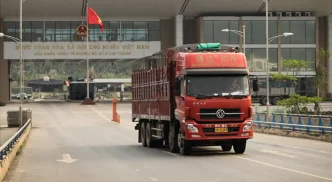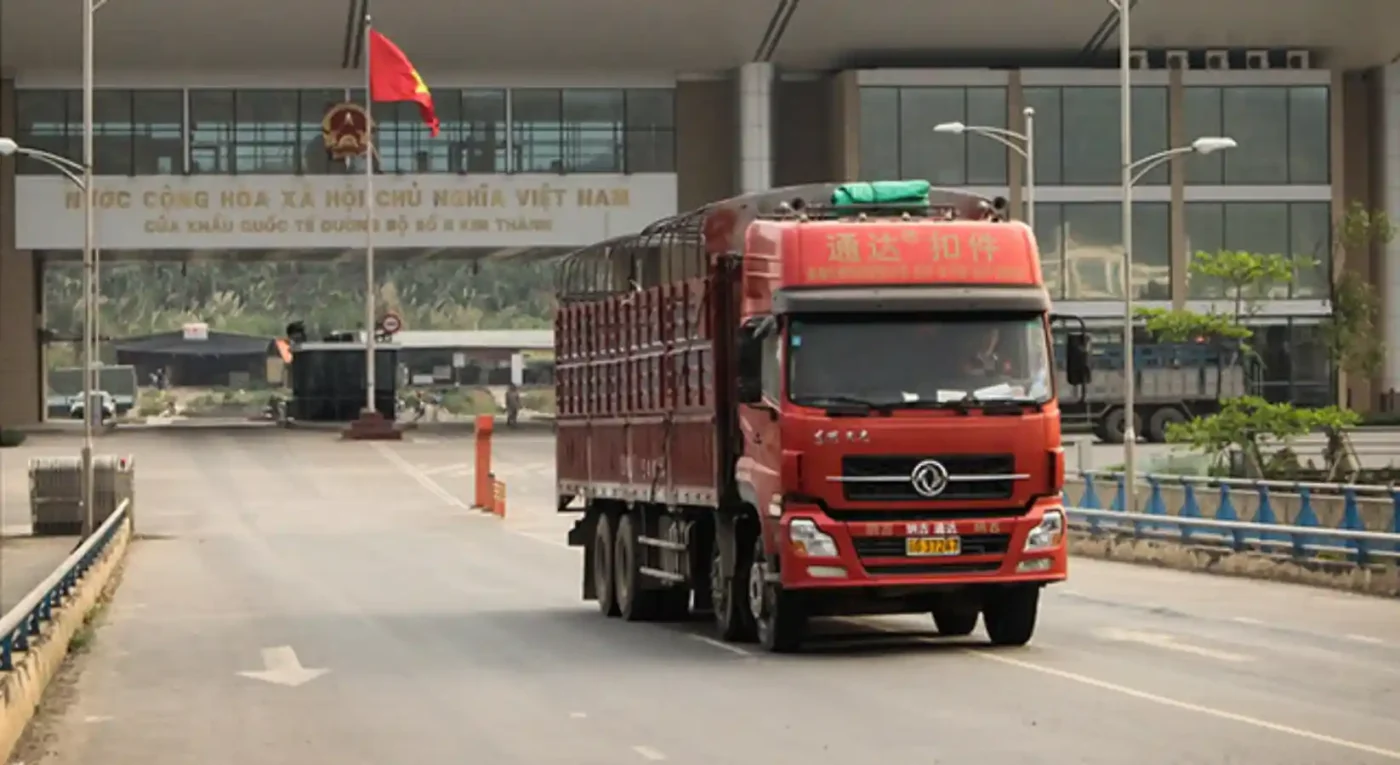In a landmark development for regional trade, a convoy of 18 freight trucks and two buses departed from China on Wednesday, bound for Hanoi, Vietnam. This journey marks the first time Chinese freight vehicles have ventured into the Vietnamese hinterland under the Cross-Border Transport Agreement of the Greater Mekong Subregion (GMS) initiative. Setting off from Kunming in Southwest China’s Yunnan province and Nanning in South China’s Guangxi Zhuang autonomous region, the convoy carries a diverse cargo load, including electronic components, fresh vegetables, and general merchandise, with an expected arrival in Vietnam’s capital on Thursday.
This pioneering trip signals a significant step forward in transport cooperation between China and Vietnam, promising to streamline cross-border logistics and bolster economic integration across the GMS—a regional framework involving six countries: Cambodia, Laos, Myanmar, Thailand, Vietnam, and China’s Yunnan province and Guangxi region. As trade ties deepen, this development could reshape supply chains and economic dynamics in Southeast Asia.
A Milestone for Regional Connectivity
The Cross-Border Transport Agreement, a cornerstone of the GMS initiative, aims to facilitate the seamless movement of goods and people across borders by harmonizing customs procedures, reducing transit times, and lowering trade costs. While the agreement has been in place for years, the deployment of Chinese freight vehicles directly into Vietnam represents a tangible breakthrough, reflecting growing trust and coordination between the two nations.
The convoy’s cargo underscores the diversity of trade between China and Vietnam, with electronic components highlighting the tech-driven nature of modern supply chains, while fresh vegetables point to the importance of agricultural trade. General merchandise, meanwhile, reflects the broad consumer demand fueling bilateral commerce. The journey from Kunming and Nanning to Hanoi, covering hundreds of kilometers, is expected to take less than 24 hours under the streamlined border protocols of the GMS framework, a significant reduction compared to previous logistics timelines that often involved multiple transshipments.
Officials from both sides have hailed the initiative as a game-changer. “This is a historic moment for our bilateral ties and for the Greater Mekong Subregion as a whole” said a spokesperson for China’s Ministry of Transport, as reported by China Daily. Vietnamese authorities have echoed similar optimism, noting the potential for reduced costs and faster delivery times to benefit businesses and consumers alike.
Economic Implications for Vietnam and Beyond
Vietnam, with its rapidly growing economy and strategic location as a gateway to Southeast Asia, stands to gain significantly from enhanced cross-border transport links. The country has emerged as a manufacturing hub in recent years, attracting foreign investment in sectors ranging from electronics to textiles. Improved logistics with China—Vietnam’s largest trading partner—could further accelerate this growth by reducing the time and cost of importing raw materials and exporting finished goods.
Trade between China and Vietnam reached over US$230 billion in 2024, according to data from Vietnam’s General Statistics Office, with China supplying critical inputs for Vietnamese industries. However, logistical bottlenecks, including lengthy customs processes and limited direct transport options, have long hindered efficiency. The direct entry of Chinese freight trucks into Vietnam’s hinterland is expected to address some of these challenges, potentially cutting transit times by up to 30%, as estimated by regional trade analysts.
Beyond bilateral trade, the initiative has broader implications for the GMS region, which collectively represents a market of over 340 million people and a combined GDP of more than US$1 trillion. By facilitating smoother cross-border movement, the agreement could strengthen regional supply chains, making the area more competitive against other global trade blocs. For instance, businesses in Thailand and Laos, which are also part of the GMS framework, could benefit from faster access to Chinese goods transiting through Vietnam, creating a ripple effect of economic gains.
Moreover, the initiative aligns with China’s Belt and Road Initiative (BRI), which seeks to enhance global connectivity through infrastructure and trade networks. While Vietnam has been cautious about fully aligning with BRI projects due to geopolitical sensitivities, this transport agreement represents a pragmatic collaboration that prioritizes mutual economic benefits over broader strategic concerns—at least for now.
Challenges and Uncertainties Ahead
Despite the optimism surrounding this milestone, challenges remain. Infrastructure disparities between China and Vietnam could pose logistical hurdles. While China has invested heavily in modern highways and border facilities in Yunnan and Guangxi, some border crossings on the Vietnamese side still face issues such as outdated customs systems and congested roads leading to Hanoi. Addressing these gaps will require sustained investment and coordination, areas where past GMS projects have sometimes faltered due to funding constraints or differing national priorities.
Additionally, there are concerns about the environmental impact of increased cross-border trucking. Heavy freight vehicles contribute to carbon emissions, and a surge in road transport could exacerbate air pollution in border regions already grappling with environmental challenges. Neither Chinese nor Vietnamese authorities have publicly outlined specific measures to mitigate these risks, raising questions about the long-term sustainability of such initiatives. If unaddressed, these issues could dampen public support for expanded transport links.
Trade imbalances also loom large. Vietnam runs a significant trade deficit with China, importing far more than it exports. While faster logistics may boost Vietnamese exports by reducing costs, some analysts caution that the immediate benefits could disproportionately favor Chinese exporters, who dominate the supply of high-value goods like electronics. Balancing these dynamics will be critical to ensuring that the agreement delivers equitable gains for both sides.
Public and Industry Reactions
Reactions to the convoy’s journey have been largely positive among Vietnamese businesses, particularly those in the manufacturing and retail sectors. “Faster transport means we can get components from China more quickly, which helps us meet tight production deadlines” said Tran Van Minh, a manager at a Hanoi-based electronics firm. Small-scale traders, too, see opportunities, with many hoping that reduced logistics costs will allow them to compete more effectively in regional markets.
Public sentiment, as gauged from social media posts on platforms like X, reflects a mix of curiosity and cautious optimism. Many Vietnamese users have expressed pride in their country’s growing role in regional trade, though some have raised concerns about increased traffic congestion in Hanoi and potential job displacement if Chinese trucking firms dominate cross-border routes. These concerns, while not yet substantiated, highlight the need for transparent policies to protect local industries and workers.
On the Chinese side, state media outlets like China Daily have framed the journey as a symbol of successful regional cooperation, emphasizing the potential for mutual prosperity. Industry stakeholders in Yunnan and Guangxi, regions that have historically served as trade gateways to Southeast Asia, are particularly enthusiastic about the new opportunities for cross-border commerce.
Geopolitical Context and Regional Dynamics
The timing of this transport milestone is noteworthy amid broader geopolitical shifts in Southeast Asia. China and Vietnam share a complex relationship, marked by historical tensions—particularly over territorial disputes in the South China Sea—and deepening economic interdependence. The successful implementation of the Cross-Border Transport Agreement could serve as a confidence-building measure, demonstrating that practical cooperation can coexist alongside unresolved disputes.
At the same time, other GMS countries are watching closely. Thailand, for instance, has its own ambitions to serve as a regional logistics hub, with projects like the Eastern Economic Corridor aiming to attract investment in transport infrastructure. The China-Vietnam transport link could spur similar initiatives elsewhere in the region, potentially accelerating the development of a truly integrated GMS transport network. However, it may also intensify competition among member states to secure favorable trade routes and investment.
External players, including the United States and Japan, which have significant economic interests in Southeast Asia, are likely to monitor these developments as well. Both countries have promoted alternative regional frameworks, such as the Indo-Pacific Economic Framework, partly as a counterbalance to China’s influence. While the GMS transport agreement is primarily an economic initiative, its alignment with China’s broader connectivity goals could influence perceptions of regional power dynamics.
Looking Ahead: A New Era of Integration?
As the first convoy of Chinese freight trucks rolls into Hanoi, it carries more than just cargo—it symbolizes the potential for a more connected and economically vibrant Greater Mekong Subregion. Yet, the journey is just the beginning. Sustaining this momentum will require addressing logistical, environmental, and economic challenges while navigating the complex interplay of national interests and regional aspirations.
For Vietnam, the arrival of these trucks marks a moment of opportunity to solidify its position as a key player in regional trade. For China, it represents another step toward realizing its vision of a seamlessly connected Asia. And for the millions of people across the GMS, it offers the promise of faster, cheaper goods and a more integrated future—if the benefits are shared equitably.
As this historic transport link unfolds, questions linger about its long-term impact on trade balances, environmental sustainability, and regional cohesion. For now, the road ahead looks promising, but its ultimate destination remains to be seen.
















